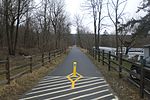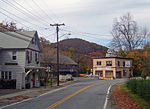Beth David Synagogue (Amenia, New York)
1920s establishments in New York (state)20th-century synagogues in the United StatesAmenia, New YorkJewish organizations established in the 1920sNational Register of Historic Places in Dutchess County, New York ... and 5 more
Reform synagogues in New York (state)Russian-Jewish culture in New York (state)Synagogues completed in 1929Synagogues on the National Register of Historic Places in New York (state)Use mdy dates from December 2023

Beth David Synagogue, formally Congregation Beth David, is a Reform Jewish congregation and synagogue located at 3344 East Main Street (also state highway NY 343) in the hamlet of Amenia, New York, in the United States. It is a small brick European-style building erected in the late 1920s. It was built by the area's small community of Russian Jewish emigrants. Over the years, its membership has dwindled and it has moved from its original Orthodox affiliation to Conservative, and eventually to Reform practices. It was added to the National Register of Historic Places in 2002, the only synagogue in New York east of the Hudson River and north of New York City to be listed.
Excerpt from the Wikipedia article Beth David Synagogue (Amenia, New York) (License: CC BY-SA 3.0, Authors, Images).Beth David Synagogue (Amenia, New York)
Church Street,
Geographical coordinates (GPS) Address Nearby Places Show on map
Geographical coordinates (GPS)
| Latitude | Longitude |
|---|---|
| N 41.846944444444 ° | E -73.554722222222 ° |
Address
Church Street
Church Street
12501
New York, United States
Open on Google Maps







